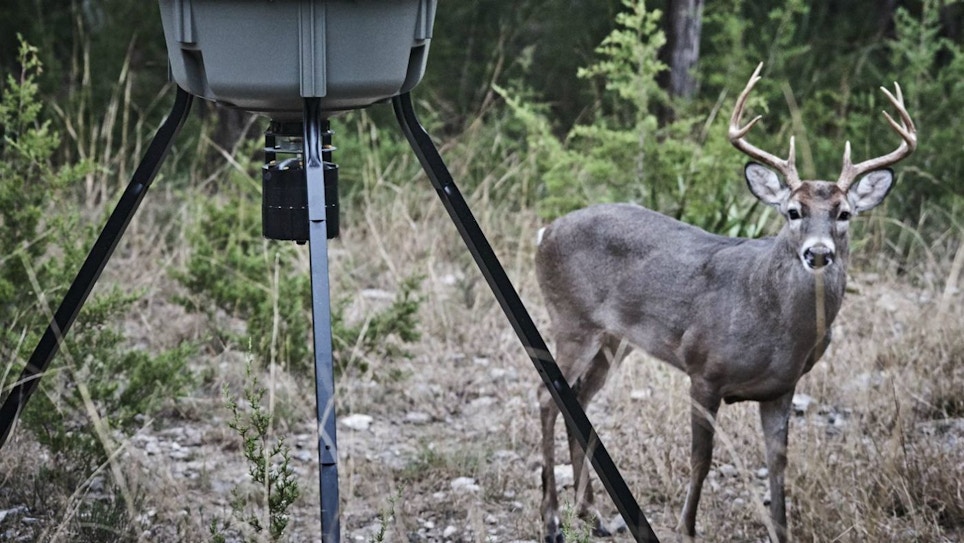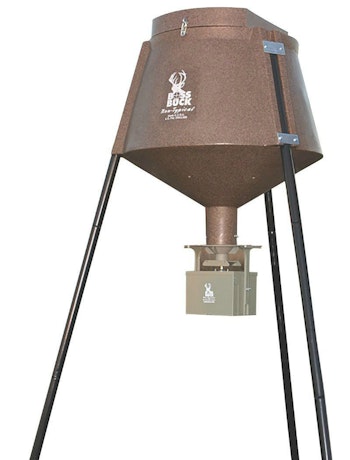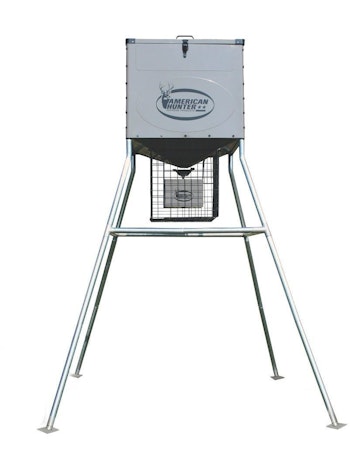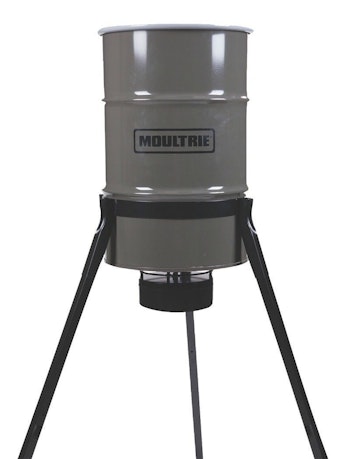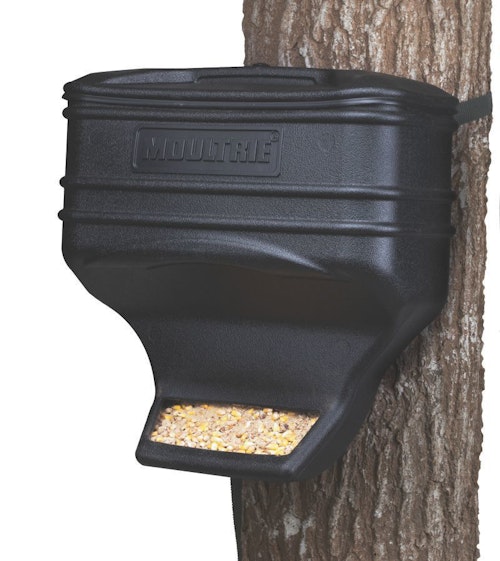Baiting and feeding wildlife is big business. Americans spent nearly $5 billion on bird and other wildlife food in 2016, according to the U.S. Fish and Wildlife Service.
There’s no telling how much of that came out of hunters’ pockets, but it’s a safe bet they spent a lot of money. Feeding and baiting deer and other game animals is wildly popular where it is legal. A 2006 survey conducted by the South Carolina Department of Natural Resources found that 94 percent of respondents used bait for hunting or to feed deer during the off-season. Most did both, providing food nearly eight months out of the year. All told, South Carolina hunters spent $18 million on feed alone. It’s even bigger business in Michigan, where bait and feed generated at least $30 million in retail sales, according to the Michigan Department of Natural Resources.
From a retailer’s perspective, that’s a gold mine. Not only do those hunters buy lots and lots of feeders, but they also buy such things as corn and protein pellets to go in them. Texas hunters bought 6 million 50-pound bags of corn in 2000, according to a Texas A&M survey.
Although there is no hard data on the number of feeders sold or the total value of those feeders, one thing is certain: Adding them to your inventory can get more people in the door and raise your bottom line. Selling feed can, too.
First, Check Your Laws
Baiting or feeding deer is legal in at least 28 states, but laws can vary. In some, it is illegal to hunt over bait, but it is perfectly legal to provide supplemental feed when hunting season is closed. Other states prohibit feeding year-round — that is, hunters can’t use any type of feed or bait ever. A few states have local or regional restrictions, while others, like Texas, have virtually no limits at all on feeding or baiting.
Even where the use of bait and feed is against the law, selling feeders typically isn’t. Neither is selling corn or any other attractant. Of course, that presents an ethical issue. Should you sell a product your customers can’t legally use?
Basics of Feeding, Baiting
First, though, it is important to understand what hunters are doing with the products you sell. Feeding deer is just that: providing food that deer and other wildlife would not have access to otherwise. It is a popular practice in the winter in northern states when natural foods are scarce.
Some hunters set up a feeder prior to hunting season and place a trail camera near it to take an inventory of their deer herd. Others provide high-quality, protein-rich feed year-round in an effort to increase animal health, antler size and the overall quality of their deer herd.
Baiting is the act of luring game animals to a specific location for the primary purpose of hunting. Bait draws deer into the open and gives hunters time to evaluate them before pulling the trigger. Generally, dried, shelled corn is the most popular bait and is ideal for use in both gravity and broadcast feeders. Some hunters use manufactured pellets made from pressed alfalfa and other ingredients. Not all types of pellets work in all types of feeders, though.
Gravity or Spin: What’s the Difference?
Gravity feeders are little more than boxes or buckets with tubes or chutes extending downward. Feed falls from the container and stops at the bottom of the tube. When deer eat that available food, more falls down the tube. Some have a single tube or chute; others have multiple tubes and are elevated off the ground with legs. They can hold anywhere from a few pounds of feed to hundreds and can be the best option for hunters who prefer pelleted food.
They are simple and have no electric or moving parts that may break, making them attractive to budget- and convenience-conscious customers. However, gravity feeders do have some disadvantages. A limited number of animals can use them at once, and there is no restriction on how much an individual animal, or what types of animals, can eat. A pair of raccoons, for example, can empty a smaller feeder in a matter of minutes if they can reach the food.
Broadcast or spin feeders are battery or solar-operated and throw feed via an electric spreader. They typically include a programmable timer, and some come with a guard to keep raccoons and squirrels out of the feed. Many hunters set that timer to go off at dawn and dusk, when deer are most likely to be active. Users can also program the length of time a feeder throws food, controlling the amount of corn that is spread and the number of times it runs in a day.
Some come with legs; others have a hook so they can hang from a limb. They vary in size from a five-gallon bucket up to feeders that can hold hundreds of pounds of shelled corn. Those larger-capacity feeders don’t have to be filled as frequently, a convenience factor that is important to some hunters. The larger the capacity, the more it will cost.
One significant disadvantage of a broadcast feeder is that non-target animals can eat the food before target game species like deer and hogs can get to it. The food falls to the ground, offering a first-come, first-served banquet for everything from squirrels and crows to raccoons and mice. Batteries can die, as well, and those electric motors may need to be replaced after a few years of exposure.
From a retailer’s perspective, offering both types of feeders provides customers more options at different price points. Gravity feeders can be inexpensive. Moultrie’s Feed Station, for example, retails for about $25. It is a simple plastic tub and open tray that straps to a tree. Others have more features and are built from more sturdy and better quality parts. They can sell for several hundred dollars, although top-of-the-line products can retail for more than $1,000. Generally, though, gravity feeders are less expensive than spin feeders, which retail from about $50 for a hanging bucket-type feeder up to $1,000 or more for a freestanding, high-capacity model.
What you sell is less important than offering at least a few options. Feeding deer and hunting over those feeders is wildly popular where it is legal. Selling them can make your store popular, too.
Here are a half dozen deer feeders to consider stocking in your store.
Boss Buck 200 Gravity Feeder
- 200-pound capacity holds corn or protein pellets
- Easily converts to broadcast feeder
- Available in single or multi-piece legs
- Built from tough roto-molded plastic
- Made in USA
- All galvanized hardware
- Starts at $259.99
- www.bossbuck.com
Boss Buck 1.2AA
- 350-pound corn capacity
- Converts to gravity feeder
- Programmable up to 16 different feed times
- Solar panel and predator guard available separately
- 12v battery included
- $499.99
- www.bossbuck.com
American Hunter 440KD
- 440-pound capacity
- LCD screen, adjustable motor control, eight daily feed times
- Powder-coated galvanized bin
- Heavy-duty legs
- 6v and 12v compatible timer
- $319.99
- www.bossbuck.com
American Hunter NF-60
- Collapsible nesting bin
- Run time adjustable from 1 to 30 seconds
- Built-in predator guard
- Easy to transport and set up
- Programmable to feed up to four times per day
- $79.99
- www.bossbuck.com
Moultrie 55-gallon Pro Magnum
- Holds up to 400 pounds of feed
- All metal container and legs
- Digital timber programmable up to six times per day, 1 to 20 seconds
- Lifetime warranty
- Built-in feed estimator, battery indicator and solar panel connectors
- $319.99
- www.moultriefeeders.com
Moultrie Feed Station
- Light, portable and easy to set up
- No batteries or moving parts
- 40-pound capacity
- Includes strap
- UV-resistant plastic
- $24.99
- www.moultriefeeders.com
